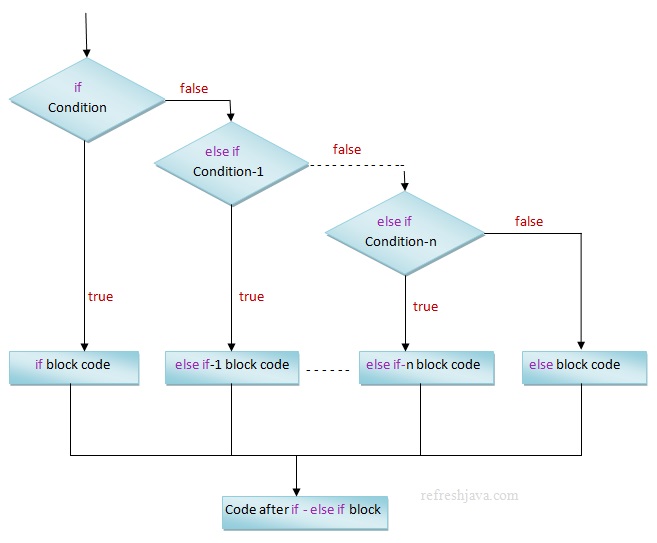Sometime as a programmer you want to use a set of conditions where in you want that if your first condition is false
then only move to check the next condition,
and if that is also false then only move to check the next condition and so on. To address such scenarios java provides if
then else if statement. You can specify another condition with else if statement which is evaluated only when it's prior
if or else if condition is false.
If the else if condition returns
true,
the else if block will be executed,
if it returns false, computer will move to next else if statement and
evaluates the condition expression. This process goes on until any of the expression returns
true or all the
else if statements are finished. Once any of the expression returns
true, code inside that conditional statement is executed and
all other condition statements after that are not executed. If all conditional statements returns
false,
then final else block(if any) will be executed.
The syntax of
if-then-else if statement is:
if(condition) {// code to be executed inside if block}else if(condition-1) {// code to be executed inside this else if block}else if(condition-2) {// code to be executed inside this else if block} . . .else if(condition-N) {// code to be executed inside this else if block}else{// code to be executed inside else block, it's optional}
The last else statement in if else-if ladder is optional, it's programmer's choice whether to use or not.
What is if-else if ladder statement in Java ?
The if.. else if statement given above is also called as else if ladder which is mostly used when programmer wants to
select one block of code among many.
In if.. else if ladder only one block(the one whose condition is true) of code is executed.
Can I use else if statement without if statement ?
No, you can not use else if statement without if statement in java. The
else if
must be used along with if statement.
Flowchart of if...else if statement

if .. else if program in Java
public classIfElseIfStatement {public static voidmain(String [] args) {intnum1 = 20, num2 = 20;if(num1 > num2) { System.out.println("num1 is greater than num2"); }else if(num1 == num2) { System.out.println("num1 is equal to num2"); }else{ System.out.println("num1 is less than num2"); } System.out.println("code to be executed after else if ladder"); } }
Output:
num1 is equal to num2
code to be executed after else if ladder
Can we use if inside else if in Java ?
Yes, we can use if statement inside else if statement, the program will run successfully.
Nested if-else statement in Java
Java allows programmer to place if else block inside another if
or else block. This is
called as nested if else statement. Programmer can do any level of nesting in program which
means you can place if else block inside another if or else block up to any number of times.
Inner if block is executed only when outer if condition is true.
if(condition-1) {// code to be executed inside first if blockif(condition-2) {// code to be executed inside second if blockif(condition-3) {// code to be executed inside third if block. . . . . . . . . . }else{// code to be executed inside else block}// code to be executed inside second if block}// code to be executed inside first if block}else{if(condition-4) {// code to be executed inside this if block} }
Nested if else program in Java
public classNestedIfElseStatement {public static voidmain(String [] args) {intnum1 = 20;if(num1 >= 10) {if(num1 < 100) { System.out.println("num1 is a double digit number"); }else{ System.out.println("num1 is not a double digit number"); } }else{ System.out.println("num1 is less than 10"); } System.out.println("code after nested if else block"); } }
Output:
num1 is a double digit number
code after nested if else block
Can we use if inside if in Java ?
Yes, this is known as nested if in java. Refer the example above.
Can we use if inside else in Java ?
Yes, this is also known as nested if else in java. Refer the example above.
- Ensure there is space between else & if, it should not be elseif.
- The else if is also part of conditional or decision making statements.
- If no curly brackets {} is used with else if keyword, only first line of code after else if keyword will be considered as part of else if statement.



